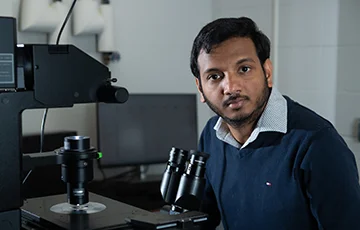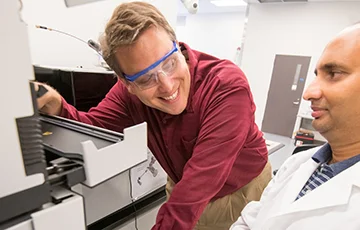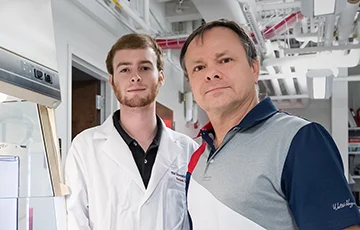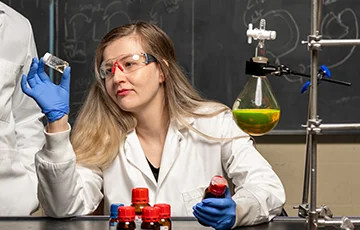Analytical, Environmental & Forensic Chemistry
Identification and quantification of chemical samples for different applications—making our lives better.
- Home
- Departmental Directory
- Liberal Arts
- Department of Chemistry & Biochemistry
- Research
- Analytical, Environmental & Forensic Chemistry
Studying Matter to Better Understand Our World
Analytical chemistry is the science of determining the composition of matter is and how much of it exists. In simpler terms, it's the study of the composition and structure of matter, encompassing both qualitative and quantitative analysis. Key aspects of analytical chemistry include qualitative analysis, quantitative analysis, separation techniques, instrumental methods, data processing and interpretation, and communication of results.
Environmental chemistry is an applied area of analytical chemistry that involves the study of chemical processes and substances in the natural world, including air, water, and soil, and how human and biological activities affect them. It examines the fate, transport, and effects of chemicals in various environments, including their impact on ecosystems and human health.
Forensic chemistry is another applied area of analytical chemistry that involves is the application of chemical principles and techniques to analyze evidence collected from crime scenes or related investigations, providing scientific evidence for legal proceedings. Forensic chemists use various analytical methods, including gas chromatography and mass spectrometry, to identify and characterize substances like drugs, fibers, and DNA.
Research Projects
-

Professor Vignesh Sundaresan
Dr. Sundaresan’s research group specializes in measurement science at the single-entity level, employing advanced electrochemical and optical techniques to investigate the fundamental electrochemical behavior of individual nanoparticles, molecules, and bioentities. Key research directions in Dr. Sundaresan’s lab include: (1) developing innovative optical methods for probing electrochemical reactions at the nanoscale; (2) performing correlated electrochemical and optical studies of electrocatalytic reactions at the single-particle level; and (3) exploring nanoscale interactions between heavy metal ions and microplastics.
The Sundaresan Laboratory -

Professor Joshua Sharp
Dr. Sharp’s group is active in the development and application of new mass spectrometry-based technologies for studying the structure-function relationships of proteins and carbohydrates of biomedical interest. Current applications focus on the study of interactions between neutralizing antibodies and the glycoprotein coat of HIV; characterization of chemokines and the structural factors mediating their oligomerization and function; and the identification of glycosaminoglycan structures with potential biomedical applications for a wide variety of fields including anti-microbial agents, anti-cancer therapies, and anti-inflammatory therapies.
Sharp Laboratory: Mass Spectrometry -

Professor James Cizdziel
With years of research experience in monitoring emerging environmental contaminants, the Cizdziel group is now focused on microplastic pollution, including tire wear particles, to better quantify their sources, occurrence, and impacts in the environment and in organisms, including humans. Using a combination of spectroscopy (chemical imaging by µ-FTIR), optical microscopy, and innovative sampling and sample preparation techniques, we aim to better understand the scope of the problem and to develop novel and sustainable solutions through rigorous scientific inquiry.
Prof. Cizdziel's Group Website -

Professor Eden Tanner
Prof. Tanner's research group seeks to solve outstanding bioengineering research questions using a chemistry framework, where an understanding of the molecular interactions within the delivery system allows the development of predictive frameworks and task-specific solvent design. Ionic liquids, consisting of a bulky, asymmetric cation and an anion, have attracted significant interest in a broad range of applications, including catalysis and energy applications, due to their favorable properties, including non-volatility, recyclability, and their inherent tuneability whereby the anion and cation can be altered to change the physicochemical properties of the material. By synthesizing the ionic liquids with biocompatible or bioinspired starting materials, they can be employed in biological contexts. Because changing the structure of the ionic components results in changes to their their biologically relevant properties, including interactions with bio-interfaces, biomolecules and pharmaceutical ingredients, they can be tuned to solve a variety of problems. Nanoparticles have been touted as ideal drug delivery systems due to their ability to deliver drugs in a more effective, safe, and specific way compared to traditional therapeutics, particularly in the context of administering chemotherapy.
Tanner Lab
Analytical Chemistry Faculty
Abby Boyd
- Assistant Professor of Chemistry
Saumen Chakraborty
- Associate Professor of Chemistry & Biochemistry
James Cizdziel
- Chair and Professor of Chemistry and Biochemistry
Nathan Hammer
- Professor of Chemistry and Biochemistry
Jonah Jurss
- Associate Professor of Chemistry & Biochemistry
Jason Ritchie
- Associate Professor of Chemistry & Biochemistry and Stefani-Miller Chair for Teaching Excellence
Joshua Sharp
- Professor of Pharmacology, Research Professor in RIPS, and Affiliated Professor of Chemistry and Biochemistry
Vig Sundaresan
- Assistant Professor of Chemistry and Biochemistry
Eden Tanner
- Assistant Professor of Chemistry and Biochemistry and Co-Director for the Center for Nano-Bio Interactions
Environmental Chemistry Faculty
Abby Boyd
- Assistant Professor of Chemistry
James Cizdziel
- Chair and Professor of Chemistry and Biochemistry
Jinchao Lou
- Assistant Professor of Chemistry and Biochemistry
Forensic Chemistry Faculty
James Cizdziel
- Chair and Professor of Chemistry and Biochemistry
Murrell Godfrey
- Assistant Dean of Access and Opportunity Pathways and Associate Professor of Chemistry
Nathan Hammer
- Professor of Chemistry and Biochemistry
Eden Tanner
- Assistant Professor of Chemistry and Biochemistry and Co-Director for the Center for Nano-Bio Interactions
